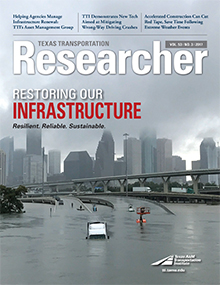As in 2013, ASCE once again rated America’s infrastructure a D+ in its latest 2017 assessment. Although several categories, such as ports and rail, achieved modest improvements, others declined. And six core categories that many think of when they think of infrastructure itself — including bridges, roads and aviation — remained unchanged from four years earlier.
The takeaway: America’s infrastructure hasn’t gotten healthier. It’s no wonder, then, that infrastructure renewal is a principal policy focus for the Trump Administration.

The Texas A&M Transportation Institute’s (TTI’s) Asset Management Group helps sponsors optimize resources to manage infrastructure improvements. From TTI’s groundbreaking application of ground-penetrating radar (GPR) to the development of other nondestructive pavement testing equipment and processes to helping agencies determine infrastructure priorities, TTI’s expertise has provided innovative solutions for decades.
“For the longest time, we simply built our way out of whatever transportation problem we faced,” explains TTI Research Engineer Andrew Wimsatt. “Now, as ASCE points out, those solutions — roads, bridges and other infrastructure elements — are failing and in need of repair or replacement. That’s what the Moving Ahead for Progress in the 21st Century Act [MAP-21] was designed to address.”
In 2012, MAP-21 restructured and provided strategic guidance for federal surface transportation spending. The act emphasized performance outcomes, which put the onus on states to demonstrate bang for the buck in order to secure federal funding. In 2015, the Fixing America’s Surface Transportation Act authorized $305 billion through 2020 to fund transportation projects nationwide.
“These days, infrastructure maintenance is as much about strategic planning as it is about filling potholes,” says Wimsatt. “Local agencies have to make resources stretch further, and also make sure the equipment and materials they use are up to code and that they have personnel properly trained to operate them. That’s where TTI can help.”
The Texas Department of Transportation (TxDOT), the U.S. Army Corps of Engineers, the Strategic Highway Research Program and the National Cooperative Highway Research Program — these are just a handful of the sponsors worldwide for whom TTI has evaluated and certified equipment, trained personnel, and provided innovative technological applications. The experts in TTI’s Asset Management Group combine engineering best practices with economic principles and proven business strategies to develop or improve tools at all levels of decision-making.
Accurate, reliable data collection and analysis are key aspects of effective asset management. The way transportation agencies collect, store and analyze data is evolving to leverage the capabilities of advancing technology.
TTI trains local personnel in how to collect and analyze data efficiently, reliably and cost-effectively to meet their needs. And Institute experts can help agencies calibrate and certify equipment to meet national standards of excellence. Whether it’s pavements, bridges, pavement markings or signs, TTI’s state-of-the-art equipment helps sponsors perform at peak accuracy and efficiency under MAP-21 requirements.
“Take the ongoing Corridor Analysis Project for TxDOT, for example,” says Wimsatt. “It’s just one example of the one-stop-shop kinds of services we offer.”
Led by TTI Senior Research Engineer Tom Scullion, TTI researchers have conducted extensive evaluations of major highway facilities — such as I-20 in West Texas and I-45 in East Texas — and helped TxDOT rank segments of these corridors in terms of needed repairs. Researchers obtained core samples of the pavement materials and analyzed them in the laboratory. The team also evaluated pavement conditions using GPR, a falling weight deflectometer and the total pavement acceptance device. Traffic volume data were collected, maintenance histories compiled for each section, and local road project priorities studied.
After evaluating all the data, TTI created four categories of needed repairs for the sections studied: roads expected to last two years, two to five years, five to ten years, and ten years or longer. After creating an optimum rehabilitation strategy for each section, TTI provided its recommendations to TxDOT’s district engineers. TxDOT officials have said TTI’s expertise helped save Texas millions in taxpayer dollars.
“What our districts really appreciate is how TTI helps us boil down all the masses of data collected in these studies into one simple, short report with detailed, project-level recommendations,” says Dar-Hao Chen of TxDOT’s Construction Division. Chen managed the Corridor Analysis Project for the department. “That helps us set priorities as we develop our 10-year pavement rehabilitation plan for each identified project.”





